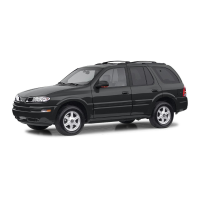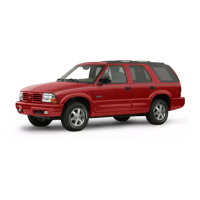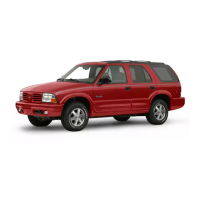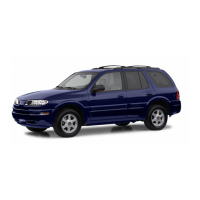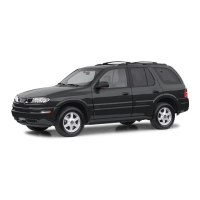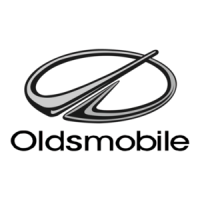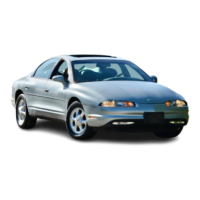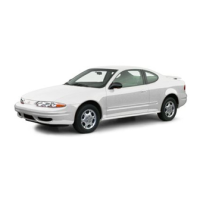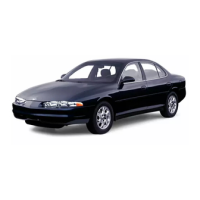Do you have a question about the Oldsmobile Bravada 1997 and is the answer not in the manual?
Information about seat adjustments and folding mechanisms.
Instructions for adjusting the manual passenger seat.
Instructions for adjusting the power driver's seat controls.
How to adjust the lumbar support on the driver's or passenger's seat.
Instructions for reclining front seatbacks and returning them to an upright position.
How to adjust head restraints for optimal protection against neck injury.
Information about folding rear seats to increase cargo space.
Guidance on proper safety belt usage for all occupants and avoiding misuse.
Explanation of how safety belts protect occupants during a crash.
Q&A addressing common concerns about safety belt and air bag usage.
Instructions for adult occupants on wearing safety belts correctly.
Description of the driver's restraint system and lap-shoulder belt usage.
Explanation of the air bag system and its function as a supplemental restraint.
What the air bag readiness light indicates and when to seek service.
Explanation of the driver's air bag location and how the system works.
Conditions for air bag inflation and how air bags restrain occupants.
What to expect after an air bag inflates and associated safety precautions.
Guidelines for servicing air bag systems and adding equipment.
Guidelines for pregnant women on proper safety belt usage.
Importance of buckling up rear seat passengers and correct belt usage.
Instructions for wearing rear seat lap-shoulder belts properly.
How to use comfort guides for child and small adult safety belts.
Instructions for wearing a center rear lap safety belt properly.
Importance of using appropriate child restraints for infants and small children.
Guidance on selecting and placing child restraints according to safety standards.
Instructions for correctly anchoring child restraint top straps.
Step-by-step guide for installing child restraints in rear seats.
Guidance on placing child restraints in center and front seats safely.
Guidance for older children on using vehicle safety belts properly.
Advice on adjusting shoulder belts for small children to ensure proper fit and safety.
Information on safety belt extenders and checking restraint system components.
When to replace safety belts, buckles, or air bag components after an accident.
Information on vehicle keys, door locks, and remote entry systems.
Procedures for starting the engine, operating the transmission, and using the parking brake.
Overview of steering wheel controls, dashboard indicators, and warning lights.
Details on climate control, audio systems, mirrors, and storage.
Details about vehicle keys, key code, and theft prevention features.
How to manually lock and unlock vehicle doors using interior and exterior methods.
Operation of power door locks, including rear door security.
How to use the keyless entry transmitter to lock/unlock doors and liftgate.
Instructions for replacing the battery in the keyless entry transmitter.
Steps to resynchronize the keyless entry transmitter if it's not working.
How to release the liftgate using the key, keyless entry, or driver's door unlock.
How to release liftgate glass and theft prevention tips.
Advice on parking safely and guidelines for new vehicle break-in.
Description of the different ignition switch positions: Accessory, Lock, Off, Run, Start.
Step-by-step guide for starting the vehicle's engine.
Information on using the optional engine coolant heater for cold weather.
Explanation of shift lever positions and transmission operation.
Safety warnings and procedures for shifting the transmission, especially into PARK.
Guidance on selecting gears for different driving conditions.
Functionality of the locking rear axle and all-wheel drive system for traction.
How to set and release the parking brake for secure parking.
Steps to ensure the vehicle is safely in PARK, especially on inclines.
Safety precautions when leaving the vehicle with the engine running.
How to prevent or resolve torque lock when parking on hills.
Steps to disengage the shift lever from PARK, including troubleshooting.
Warning about parking over flammable materials to prevent fires.
Dangers of carbon monoxide from exhaust and how to detect it.
Precautions for idling the engine, especially in enclosed spaces.
How to operate power windows, including express-down and lockout features.
How to use the vehicle's horn.
How to adjust the steering wheel for driving comfort.
Controls for turn signals, wipers, washer, and cruise control.
How to use turn signals and what to do if bulbs are out.
How to switch between high and low beam headlights.
How to use windshield wipers and washers for clear visibility.
How to operate the rear window wiper and washer system.
How to engage and use cruise control for maintaining speed.
Precautions and steps for setting cruise control to avoid unintended activation.
How to adjust speed, resume, and pass while using cruise control.
Advice on using cruise control effectively on hilly terrain.
How to turn off cruise control and erase stored speed memory.
How to operate parking, side marker, taillamps, and license plate lights.
Explanation of DRLs, their operation, and indicator light.
How to use fog lamps for improved visibility in foggy conditions.
How to adjust instrument panel brightness and operate interior lamps.
How to operate front and rear dome lamps, and cargo area lamp.
How to adjust the rearview mirror to reduce glare.
How to adjust and fold the exterior mirrors.
How to adjust side mirrors using the driver's door controls.
Warning about convex mirrors and lane changing safety.
How to open and use the glove box and other storage areas.
Description of overhead console components including reading lamps.
How to operate and adjust the reading lamps.
How the system displays outside temperature, compass, and trip data.
How to calibrate the vehicle's compass system for accuracy.
How to set compass variance based on location for accurate readings.
How to use the trip computer for fuel economy, range, and speed data.
How to open and use sunglasses storage, door storage, and front storage.
How to install and use the cargo convenience net.
How to use the cargo security shade and safety precautions.
How to use cargo tie-downs and load items onto the luggage carrier.
Safety warnings and guidelines for loading items onto the luggage carrier.
How to use the cigarette lighter and ashtrays, with safety notices.
How to adjust sun visors for glare protection and their features.
How to use the vanity mirror and illuminated vanity mirror.
How to use power outlets and electrical load limitations.
How to operate the power sliding sunroof and its sunshade.
Information about the universal transmitter and console features.
How to program the universal transmitter for garage doors.
Detailed steps for programming the universal transmitter with garage door openers.
How to erase transmitter channels and train rolling code openers.
Diagram identifying major components of the instrument panel.
Explanation of the gauges and indicators on the instrument cluster.
How to read the speedometer, odometer, and trip odometer.
How to read the tachometer for engine speed and operating ranges.
Explanation of vehicle warning lights and gauges for monitoring system status.
How the safety belt reminder light and audible alert function.
What the air bag readiness light indicates and when to seek service.
What the charging system light indicates about the battery and alternator.
How to read the voltmeter for battery state and charging system condition.
How the brake system warning light indicates potential problems.
What the ABS warning light signifies and when service is needed.
How to read the coolant temperature gauge and what overheating means.
What the service engine soon light indicates and potential causes.
Differentiating between flashing and steady service engine soon light conditions.
Steps to take to prevent further damage if the malfunction light is flashing.
Potential causes and solutions if the malfunction indicator lamp is steady.
How fuel quality affects engine performance and potential knocking.
How to read the engine oil pressure gauge and what low pressure indicates.
What low oil pressure means and the dangers of continuing to drive.
What the DRL indicator light on the instrument panel signifies.
When the check gages light illuminates and what to inspect.
What the gate ajar light indicates and how to resolve it.
How to read the fuel gauge and common owner questions about its behavior.
How to use the climate control system for heating, cooling, and ventilation.
How to adjust temperature and air delivery direction using the control knobs.
How to adjust the fan speed for airflow.
How to use HEATER, BLEND, and DEFROST modes for cabin comfort.
Tips for using the air conditioning for quick cooling and odor control.
How to use the heater effectively in cold and cool weather.
How to use the ventilation system for fresh air circulation.
Tips for optimizing ventilation, including clearing air paths.
How to use BLEND and DEFROST modes for clear visibility.
How to operate and use the rear window defogger.
Introduction to the Delco audio system and its capabilities.
Instructions for setting the clock on different audio system models.
How to operate the AM-FM stereo, cassette player, and equalizer.
How to find stations using AM-FM, Tune, Seek, and Scan functions.
How to preset favorite radio stations using pushbuttons.
How to adjust bass, midrange, and treble for desired sound quality.
How to adjust sound balance between left/right and front/rear speakers.
How to play, reverse, forward, and search cassette tapes.
How to operate the AM-FM stereo and compact disc player.
How to tune radio stations and use AM-FM selection.
How SCV automatically adjusts volume based on vehicle speed and road noise.
How to use SCAN to preview stations and P.SCAN for favorite stations.
How to adjust bass and treble settings for optimal audio.
How to select preset equalization settings or use manual tone control.
How to insert, play, and troubleshoot compact discs.
How to use Prev, Fwd, AM-FM, Recall, CD AUX, and Eject controls.
Step-by-step instructions to activate the radio's theft-deterrent system.
How to unlock the radio after battery power is removed.
Steps to disable the radio's theft-deterrent system.
Factors affecting FM and AM radio reception quality.
Precautions for safe audio system use and hearing protection.
Advice on driving defensively, anticipating hazards, and maintaining following distance.
Information on the effects of alcohol on driving skills and crash risks.
Factors influencing BAC and legal limits for driving.
How alcohol impairs driving skills, increases crash risk, and worsens injuries.
Overview of the three systems controlling vehicle movement: brakes, steering, accelerator.
Explanation of perception time, reaction time, and stopping distances.
How road surface, tires, brakes, and vehicle weight affect stopping distance.
How ABS works to prevent braking skids and the function of the ABS warning light.
Advice on braking normally and what to do if the engine stops while driving.
How to use ABS effectively and what to expect during operation.
How steering can assist braking in emergencies and avoid collisions.
Factors affecting cornering traction and how to adjust speed safely.
How to use steering for evasive action to avoid potential collisions.
How to safely recover the vehicle when wheels drop off the road edge.
Tips for safely passing other vehicles on two-lane highways.
Understanding situations that lead to loss of vehicle control.
Causes and types of vehicle skids: braking, steering, and acceleration.
General guidelines for operating utility vehicles, including design characteristics.
Guide to operating the Bravada in off-road conditions and terrain.
Checks and preparations needed before going off-road, including maintenance and laws.
How to load the vehicle for off-road driving, focusing on weight and cargo security.
Rules for protecting the environment while driving off-road.
Advice on planning trips to remote areas, including mapping and travel partners.
Tips for getting familiar with off-road driving skills and terrain signals.
Importance of controlling speed for off-road driving and factors affecting it.
How to scan terrain for obstacles, surface changes, and potential hazards.
Techniques for driving over bumps, rocks, and rough surfaces.
Guidance and warnings for driving on steep hills and mountainous terrain.
Factors to consider when approaching hills, including steepness and surface conditions.
Steps for driving uphill, including gear selection and avoiding sideways driving.
Precautions when approaching the top of a hill, including visibility and hazards.
What to do if the vehicle stalls or is about to stall while going uphill.
How to back down a hill safely, including steering techniques.
Actions to avoid if the vehicle stalls on an incline, like shifting to neutral.
Considerations for driving downhill, including gear selection and avoiding turns.
Warnings against coasting in neutral and heavy braking downhill.
Steps to take if the vehicle stalls while descending a hill.
Dangers of driving across inclines due to vehicle tilt and surface conditions.
Warnings about the risk of rollover and serious injury when driving across steep inclines.
How to correct a sideways slide on an incline by turning downhill.
Safety precautions for exiting a vehicle stalled on an incline, focusing on uphill exit.
How mud, sand, snow, and ice affect traction, acceleration, and braking.
Considerations for acceleration, turning, and braking in slippery conditions.
Safety precautions for driving through water, including flood risks.
Warnings and advice for driving through deep water and potential engine damage.
What to do after off-road driving, including debris removal and system checks.
General tips for safer night driving, including visibility and rest.
How age, daytime activities, and glass condition affect night vision.
How wet roads reduce traction and visibility, and wiper maintenance.
Risks of driving through puddles, including wet brakes and hydroplaning.
What hydroplaning is, its causes, and how to avoid it.
Warnings and advice for driving through deep water and potential engine damage.
Tips for navigating city streets safely, including planning routes and traffic signals.
Advice on merging onto freeways and proper lane usage.
Procedures for merging onto freeways and changing lanes safely.
How to exit freeways safely and adjust speed according to the speedometer.
Key vehicle checks and personal preparations for a long trip.
Understanding and preventing highway hypnosis or driver fatigue.
Tips for safer driving on steep or mountainous terrain.
Importance of shifting to lower gears for downhill descents to assist brakes.
How to drive uphill, including gear selection and maintaining lane position.
Tips for preparing the vehicle for winter driving and emergency supplies.
How snow and ice affect traction and the need for careful driving.
Advice on accelerating, braking, and steering on ice and snow.
Steps to take if stranded in a blizzard, including summoning help and staying warm.
Warning about CO buildup from exhaust in snow and how to prevent it.
Importance of respecting GVWR and GAWR, and proper load distribution.
Safety precautions for securing interior cargo to prevent injury during sudden stops or crashes.
Warnings and requirements for towing a trailer safely.
Recommendations for the initial towing period and speed limits.
Factors affecting safe trailer weight and the importance of tongue weight.
Correct hitch types and tongue weight percentages for safe towing.
Importance of proper tire inflation and not exceeding vehicle weight limits.
Color code chart for connecting trailer wiring harnesses.
How to use hazard flashers and their effect on turn signals and brakes.
Safety warnings regarding car batteries and the jump starting procedure.
Steps for positioning vehicles, connecting jumper cables, and initial startup.
How to safely remove jumper cables and final checks after starting.
Recommendation for professional towing and vehicle preparation steps.
Safety measures for towing, including securing the vehicle and avoiding substitutes.
Steps to override the solenoid lock for shifting from PARK to NEUTRAL without power.
Towing limits and required equipment for front towing.
Towing limits and required equipment for rear towing.
Safety precautions when dealing with steam from an overheated engine.
What to do if the overheat warning is on but no steam is visible.
What to look for under the hood when the engine is overheated.
How to check coolant levels and identify potential leaks in the cooling system.
How to add coolant to the recovery tank safely.
Correct coolant mixture and safety warnings for adding coolant.
Importance of the radiator cap's pressure rating and proper installation.
How the thermostat regulates engine coolant temperature.
When to check power steering fluid and how to check and add it.
How to select and add windshield washer fluid, including freeze protection.
Location of brake fluid reservoir and reasons for fluid level changes.
Why it's not advisable to top off brake fluid and the risks of spills.
How to check brake fluid level without removing the cap.
Using the correct DOT-3 brake fluid and avoiding spills on paint.
How to identify worn brake pads by sound and the need for service.
Importance of proper wheel nut torque for brake performance.
What abnormal brake pedal travel might indicate and self-adjusting brakes.
Importance of using genuine GM parts for brake system replacements.
How to prepare the vehicle for storage, including battery disconnection.
Information about the Delco Freedom battery and its maintenance.
General procedures for replacing vehicle bulbs.
Safety warnings about handling pressurized halogen bulbs.
Step-by-step guide to replacing composite headlamp bulbs.
How to replace front turn signal lamp bulbs.
How to replace the center high-mounted stoplamp.
How to replace taillamp assemblies.
How to replace the underhood lamp bulb.
How to replace bulbs in the front reading lamps.
How to replace bulbs in the vanity mirror lamps.
Steps for removing and installing windshield wiper blades safely.
How to replace the wiper blade insert correctly.
How to reattach the wiper arm and blade assembly to the windshield.
How to replace the backglass wiper blade, noting differences from windshield wipers.
Warnings about poorly maintained and improperly used tires, including overloading and inflation.
Importance of correct tire inflation and consequences of under/overinflation.
How to check tire pressure using a gauge and the importance of valve caps.
Why and how to rotate tires for uniform wear, and tightening wheel nuts.
How to tell when new tires are needed based on treadwear indicators and damage.
How to choose new tires based on TPC Spec, size, load range, and construction.
Warnings about mixing tires of different sizes or types and potential vehicle damage.
Explanation of tire grading for treadwear, traction, and temperature.
How tire treadwear is rated and factors affecting wear.
Tire traction grades (A, B, C) and their meaning for stopping on wet surfaces.
Tire temperature grades (A, B, C) and their relation to heat generation and tire failure.
When alignment and balance may be needed and how to identify issues.
When to replace wheels and the importance of using genuine GM parts.
Dangers of using used wheels and the recommendation for new GM original equipment wheels.
Warnings about using tire chains due to clearance issues and potential vehicle damage.
General guidelines for maintaining the vehicle's appearance.
List of cleaning products that are hazardous or can damage the vehicle.
How to clean interior surfaces and remove stains.
General tips for cleaning interior surfaces and stains.
Step-by-step guides for cleaning fabric surfaces with foam or solvent cleaners.
Methods for removing greasy, non-greasy, and combination stains from surfaces.
How to clean vinyl interior surfaces.
How to clean leather seats and avoid damaging products.
How to clean interior and exterior glass, avoiding abrasives and decals.
How to clean the instrument panel top surface safely.
How to clean and care for safety belts to maintain their strength.
How to clean windshields, backglass, and wiper blades.
How to maintain weatherstrips for better sealing and longevity.
Best practices for washing the vehicle's exterior to preserve paint finish.
How to care for the paint finish, including waxing and avoiding aggressive polishing.
How to clean and protect exterior bright metal parts, including aluminum trim.
How to clean aluminum wheels safely without damage.
How to clean tires and apply dressing, with warnings about overspray.
Ensuring anti-corrosion material is applied during sheet metal repair.
Importance of prompt repair for stone chips and scratches to prevent corrosion.
How to flush the underbody to remove corrosive materials and prevent rust.
Explanation of chemical paint spotting and limited warranty coverage for it.
What the VIN is and where to find it on the vehicle.
How the 8th character of the VIN identifies the engine code.
Where to find the service parts label and the information it contains.
Warnings and guidelines for adding electrical equipment to the vehicle.
How the headlamp wiring is protected by a circuit breaker.
How the wiper motor is protected by a circuit breaker and fuse.
How circuit breakers protect power windows and accessories from overloads.
How fuses and circuit breakers protect vehicle wiring circuits.
Location of the fuse block and how to access it.
Overview of fuses for lighting, safety, and powertrain systems.
Chart listing bulb types, quantities, and part numbers for vehicle lamps.
Table of engine, fluid capacities, and vehicle dimensions.
List of common replacement part numbers for routine maintenance.
List of approximate fluid capacities for various vehicle systems.
Specifications for vehicle wheelbase, length, height, and tread.
Importance of using the correct refrigerant for the A/C system.
How proper maintenance keeps the vehicle running well and protects the environment.
Overview of the five parts of the maintenance section and safety warnings.
How to use the maintenance schedule based on driving habits and conditions.
How to choose between short trip/city and long trip/highway maintenance schedules.
Conditions defining short trip/city driving that require more frequent maintenance.
Schedule of services for short trip/city driving, including mileage and time intervals.
Conditions defining long trip/highway driving that allow for less frequent maintenance.
Schedule of services for long trip/highway driving, including mileage and time intervals.
Specific maintenance items and intervals for short trip/city driving, with footnotes.
Maintenance tasks for 3,000 and 6,000 mile intervals in short trip/city driving.
Maintenance tasks for 9,000 and 12,000 mile intervals in short trip/city driving.
Maintenance tasks for 15,000 and 18,000 mile intervals in short trip/city driving.
Maintenance tasks for 21,000 and 24,000 mile intervals in short trip/city driving.
Maintenance tasks for 27,000 and 30,000 mile intervals in short trip/city driving.
Maintenance tasks for 33,000 and 36,000 mile intervals in short trip/city driving.
Maintenance tasks for 39,000 and 42,000 mile intervals in short trip/city driving.
Maintenance tasks for 45,000 and 48,000 mile intervals in short trip/city driving.
Maintenance tasks for 51,000 and 54,000 mile intervals in short trip/city driving.
Maintenance tasks for 57,000 and 60,000 mile intervals in short trip/city driving.
Maintenance tasks for 63,000 and 66,000 mile intervals in short trip/city driving.
Maintenance tasks for 69,000 and 72,000 mile intervals in short trip/city driving.
Maintenance tasks for 75,000 and 78,000 mile intervals in short trip/city driving.
Maintenance tasks for 81,000 and 84,000 mile intervals in short trip/city driving.
Maintenance tasks for 87,000 and 90,000 mile intervals in short trip/city driving.
Maintenance tasks for 93,000 and 96,000 mile intervals in short trip/city driving.
Maintenance tasks for 99,000 and 100,000 mile intervals in short trip/city driving.
Continuation of maintenance tasks for 100,000 miles in short trip/city driving.
Maintenance tasks for 150,000 miles in short trip/city driving, including cooling system service.
Schedule of services for long trip/highway driving, with footnotes.
Maintenance tasks for 7,500 and 15,000 mile intervals in long trip/highway driving.
Maintenance tasks for 22,500 and 30,000 mile intervals in long trip/highway driving.
Maintenance tasks for 37,500 mile intervals in long trip/highway driving.
Maintenance tasks for 45,000 and 50,000 mile intervals in long trip/highway driving.
Maintenance tasks for 52,500 and 60,000 mile intervals in long trip/highway driving.
Maintenance tasks for 67,500 mile intervals in long trip/highway driving.
Maintenance tasks for 75,000 and 82,500 mile intervals in long trip/highway driving.
Maintenance tasks for 90,000 and 97,500 mile intervals in long trip/highway driving.
Continuation of maintenance tasks for 100,000 miles in long trip/highway driving.
Maintenance tasks for 150,000 miles in long trip/highway driving, including cooling system service.
Owner checks and services to ensure vehicle safety and performance.
Items to check each time you refuel the vehicle.
Routine checks to perform on the vehicle at least once a month.
Inspect restraint systems, wiper blades, and transmission.
Lubricating key cylinders and body components annually.
How to check if the starter switch works correctly in PARK and NEUTRAL.
How to check if the BTSI system prevents shifting out of PARK without brake application.
Checking that the ignition key locks only in PARK.
How to check the holding ability of the parking brake and transmission PARK mechanism.
How to flush the underbody to remove corrosive materials.
Inspections and services to be performed by a GM retailer or qualified center.
Inspecting steering, suspension, and drive axle components for damage or wear.
Inspecting the exhaust system for damage, leaks, and heat buildup.
Inspecting radiator and heater hoses for deterioration or leaks.
Inspecting throttle linkage for interference, binding, or wear.
Checking drive axle fluid levels and seals.
Checking front axle, transfer case, and control linkage lubrication.
Inspecting brake lines, hoses, pads, rotors, and parking brake.
List of recommended fluids and lubricants for vehicle maintenance.
Recommended engine oil types and coolant mixtures for your vehicle.
Recommended brake fluid and power steering fluid types.
Recommended automatic transmission fluid and chassis lubricants.
Recommended fluids for axles, transfer case, and windshield washer.
Lubrication points for hood, hinges, and weatherstrip care.
Section for recording vehicle maintenance services.
How to record completed maintenance services for future reference.
Steps for resolving concerns with retail facility management.
How to contact Oldsmobile Customer Assistance for unresolved concerns.
Information needed when contacting customer assistance for prompt service.
How customers using Text Telephones can contact Oldsmobile.
Features, benefits, and availability of the Oldsmobile Roadside Assistance program.
Contact number and coverage details for roadside assistance.
Details on shuttle rides, loaner cars, or reimbursement for transportation during warranty service.
Information about the BBB AUTO LINE program for settling automotive disputes.
How the BBB AUTO LINE program mediates and arbitrates disputes.
How to report vehicle safety defects to NHTSA and GM.
How to report safety defects to Transport Canada and GM Canada.
How to obtain service manuals and literature in Canada.
Information and pricing for service manuals, repair manuals, and owner publications.
Index entries for vehicle controls and features, including air bags and audio systems.
Index entries related to driving techniques, road conditions, and vehicle dynamics.
Index entries for engine, fluids, fuel, and gauges.
Index entries for vehicle lamps, locks, warning lights, and related systems.
Index entries for maintenance schedules, owner checks, and records.
Index entries for tire pressure, wheel alignment, and brake system components.
Index entries related to towing, trailers, hitches, and safety chains.
Index entries for VIN, electrical systems, fuses, and circuit breakers.
Index entry for service station checkpoints and quick reference locations.
Index entries for luggage carrier operation and cargo loading.
Information about seat adjustments and folding mechanisms.
Instructions for adjusting the manual passenger seat.
Instructions for adjusting the power driver's seat controls.
How to adjust the lumbar support on the driver's or passenger's seat.
Instructions for reclining front seatbacks and returning them to an upright position.
How to adjust head restraints for optimal protection against neck injury.
Information about folding rear seats to increase cargo space.
Guidance on proper safety belt usage for all occupants and avoiding misuse.
Explanation of how safety belts protect occupants during a crash.
Q&A addressing common concerns about safety belt and air bag usage.
Instructions for adult occupants on wearing safety belts correctly.
Description of the driver's restraint system and lap-shoulder belt usage.
Explanation of the air bag system and its function as a supplemental restraint.
What the air bag readiness light indicates and when to seek service.
Explanation of the driver's air bag location and how the system works.
Conditions for air bag inflation and how air bags restrain occupants.
What to expect after an air bag inflates and associated safety precautions.
Guidelines for servicing air bag systems and adding equipment.
Guidelines for pregnant women on proper safety belt usage.
Importance of buckling up rear seat passengers and correct belt usage.
Instructions for wearing rear seat lap-shoulder belts properly.
How to use comfort guides for child and small adult safety belts.
Instructions for wearing a center rear lap safety belt properly.
Importance of using appropriate child restraints for infants and small children.
Guidance on selecting and placing child restraints according to safety standards.
Instructions for correctly anchoring child restraint top straps.
Step-by-step guide for installing child restraints in rear seats.
Guidance on placing child restraints in center and front seats safely.
Guidance for older children on using vehicle safety belts properly.
Advice on adjusting shoulder belts for small children to ensure proper fit and safety.
Information on safety belt extenders and checking restraint system components.
When to replace safety belts, buckles, or air bag components after an accident.
Information on vehicle keys, door locks, and remote entry systems.
Procedures for starting the engine, operating the transmission, and using the parking brake.
Overview of steering wheel controls, dashboard indicators, and warning lights.
Details on climate control, audio systems, mirrors, and storage.
Details about vehicle keys, key code, and theft prevention features.
How to manually lock and unlock vehicle doors using interior and exterior methods.
Operation of power door locks, including rear door security.
How to use the keyless entry transmitter to lock/unlock doors and liftgate.
Instructions for replacing the battery in the keyless entry transmitter.
Steps to resynchronize the keyless entry transmitter if it's not working.
How to release the liftgate using the key, keyless entry, or driver's door unlock.
How to release liftgate glass and theft prevention tips.
Advice on parking safely and guidelines for new vehicle break-in.
Description of the different ignition switch positions: Accessory, Lock, Off, Run, Start.
Step-by-step guide for starting the vehicle's engine.
Information on using the optional engine coolant heater for cold weather.
Explanation of shift lever positions and transmission operation.
Safety warnings and procedures for shifting the transmission, especially into PARK.
Guidance on selecting gears for different driving conditions.
Functionality of the locking rear axle and all-wheel drive system for traction.
How to set and release the parking brake for secure parking.
Steps to ensure the vehicle is safely in PARK, especially on inclines.
Safety precautions when leaving the vehicle with the engine running.
How to prevent or resolve torque lock when parking on hills.
Steps to disengage the shift lever from PARK, including troubleshooting.
Warning about parking over flammable materials to prevent fires.
Dangers of carbon monoxide from exhaust and how to detect it.
Precautions for idling the engine, especially in enclosed spaces.
How to operate power windows, including express-down and lockout features.
How to use the vehicle's horn.
How to adjust the steering wheel for driving comfort.
Controls for turn signals, wipers, washer, and cruise control.
How to use turn signals and what to do if bulbs are out.
How to switch between high and low beam headlights.
How to use windshield wipers and washers for clear visibility.
How to operate the rear window wiper and washer system.
How to engage and use cruise control for maintaining speed.
Precautions and steps for setting cruise control to avoid unintended activation.
How to adjust speed, resume, and pass while using cruise control.
Advice on using cruise control effectively on hilly terrain.
How to turn off cruise control and erase stored speed memory.
How to operate parking, side marker, taillamps, and license plate lights.
Explanation of DRLs, their operation, and indicator light.
How to use fog lamps for improved visibility in foggy conditions.
How to adjust instrument panel brightness and operate interior lamps.
How to operate front and rear dome lamps, and cargo area lamp.
How to adjust the rearview mirror to reduce glare.
How to adjust and fold the exterior mirrors.
How to adjust side mirrors using the driver's door controls.
Warning about convex mirrors and lane changing safety.
How to open and use the glove box and other storage areas.
Description of overhead console components including reading lamps.
How to operate and adjust the reading lamps.
How the system displays outside temperature, compass, and trip data.
How to calibrate the vehicle's compass system for accuracy.
How to set compass variance based on location for accurate readings.
How to use the trip computer for fuel economy, range, and speed data.
How to open and use sunglasses storage, door storage, and front storage.
How to install and use the cargo convenience net.
How to use the cargo security shade and safety precautions.
How to use cargo tie-downs and load items onto the luggage carrier.
Safety warnings and guidelines for loading items onto the luggage carrier.
How to use the cigarette lighter and ashtrays, with safety notices.
How to adjust sun visors for glare protection and their features.
How to use the vanity mirror and illuminated vanity mirror.
How to use power outlets and electrical load limitations.
How to operate the power sliding sunroof and its sunshade.
Information about the universal transmitter and console features.
How to program the universal transmitter for garage doors.
Detailed steps for programming the universal transmitter with garage door openers.
How to erase transmitter channels and train rolling code openers.
Diagram identifying major components of the instrument panel.
Explanation of the gauges and indicators on the instrument cluster.
How to read the speedometer, odometer, and trip odometer.
How to read the tachometer for engine speed and operating ranges.
Explanation of vehicle warning lights and gauges for monitoring system status.
How the safety belt reminder light and audible alert function.
What the air bag readiness light indicates and when to seek service.
What the charging system light indicates about the battery and alternator.
How to read the voltmeter for battery state and charging system condition.
How the brake system warning light indicates potential problems.
What the ABS warning light signifies and when service is needed.
How to read the coolant temperature gauge and what overheating means.
What the service engine soon light indicates and potential causes.
Differentiating between flashing and steady service engine soon light conditions.
Steps to take to prevent further damage if the malfunction light is flashing.
Potential causes and solutions if the malfunction indicator lamp is steady.
How fuel quality affects engine performance and potential knocking.
How to read the engine oil pressure gauge and what low pressure indicates.
What low oil pressure means and the dangers of continuing to drive.
What the DRL indicator light on the instrument panel signifies.
When the check gages light illuminates and what to inspect.
What the gate ajar light indicates and how to resolve it.
How to read the fuel gauge and common owner questions about its behavior.
How to use the climate control system for heating, cooling, and ventilation.
How to adjust temperature and air delivery direction using the control knobs.
How to adjust the fan speed for airflow.
How to use HEATER, BLEND, and DEFROST modes for cabin comfort.
Tips for using the air conditioning for quick cooling and odor control.
How to use the heater effectively in cold and cool weather.
How to use the ventilation system for fresh air circulation.
Tips for optimizing ventilation, including clearing air paths.
How to use BLEND and DEFROST modes for clear visibility.
How to operate and use the rear window defogger.
Introduction to the Delco audio system and its capabilities.
Instructions for setting the clock on different audio system models.
How to operate the AM-FM stereo, cassette player, and equalizer.
How to find stations using AM-FM, Tune, Seek, and Scan functions.
How to preset favorite radio stations using pushbuttons.
How to adjust bass, midrange, and treble for desired sound quality.
How to adjust sound balance between left/right and front/rear speakers.
How to play, reverse, forward, and search cassette tapes.
How to operate the AM-FM stereo and compact disc player.
How to tune radio stations and use AM-FM selection.
How SCV automatically adjusts volume based on vehicle speed and road noise.
How to use SCAN to preview stations and P.SCAN for favorite stations.
How to adjust bass and treble settings for optimal audio.
How to select preset equalization settings or use manual tone control.
How to insert, play, and troubleshoot compact discs.
How to use Prev, Fwd, AM-FM, Recall, CD AUX, and Eject controls.
Step-by-step instructions to activate the radio's theft-deterrent system.
How to unlock the radio after battery power is removed.
Steps to disable the radio's theft-deterrent system.
Factors affecting FM and AM radio reception quality.
Precautions for safe audio system use and hearing protection.
Advice on driving defensively, anticipating hazards, and maintaining following distance.
Information on the effects of alcohol on driving skills and crash risks.
Factors influencing BAC and legal limits for driving.
How alcohol impairs driving skills, increases crash risk, and worsens injuries.
Overview of the three systems controlling vehicle movement: brakes, steering, accelerator.
Explanation of perception time, reaction time, and stopping distances.
How road surface, tires, brakes, and vehicle weight affect stopping distance.
How ABS works to prevent braking skids and the function of the ABS warning light.
Advice on braking normally and what to do if the engine stops while driving.
How to use ABS effectively and what to expect during operation.
How steering can assist braking in emergencies and avoid collisions.
Factors affecting cornering traction and how to adjust speed safely.
How to use steering for evasive action to avoid potential collisions.
How to safely recover the vehicle when wheels drop off the road edge.
Tips for safely passing other vehicles on two-lane highways.
Understanding situations that lead to loss of vehicle control.
Causes and types of vehicle skids: braking, steering, and acceleration.
General guidelines for operating utility vehicles, including design characteristics.
Guide to operating the Bravada in off-road conditions and terrain.
Checks and preparations needed before going off-road, including maintenance and laws.
How to load the vehicle for off-road driving, focusing on weight and cargo security.
Rules for protecting the environment while driving off-road.
Advice on planning trips to remote areas, including mapping and travel partners.
Tips for getting familiar with off-road driving skills and terrain signals.
Importance of controlling speed for off-road driving and factors affecting it.
How to scan terrain for obstacles, surface changes, and potential hazards.
Techniques for driving over bumps, rocks, and rough surfaces.
Guidance and warnings for driving on steep hills and mountainous terrain.
Factors to consider when approaching hills, including steepness and surface conditions.
Steps for driving uphill, including gear selection and avoiding sideways driving.
Precautions when approaching the top of a hill, including visibility and hazards.
What to do if the vehicle stalls or is about to stall while going uphill.
How to back down a hill safely, including steering techniques.
Actions to avoid if the vehicle stalls on an incline, like shifting to neutral.
Considerations for driving downhill, including gear selection and avoiding turns.
Warnings against coasting in neutral and heavy braking downhill.
Steps to take if the vehicle stalls while descending a hill.
Dangers of driving across inclines due to vehicle tilt and surface conditions.
Warnings about the risk of rollover and serious injury when driving across steep inclines.
How to correct a sideways slide on an incline by turning downhill.
Safety precautions for exiting a vehicle stalled on an incline, focusing on uphill exit.
How mud, sand, snow, and ice affect traction, acceleration, and braking.
Considerations for acceleration, turning, and braking in slippery conditions.
Safety precautions for driving through water, including flood risks.
Warnings and advice for driving through deep water and potential engine damage.
What to do after off-road driving, including debris removal and system checks.
General tips for safer night driving, including visibility and rest.
How age, daytime activities, and glass condition affect night vision.
How wet roads reduce traction and visibility, and wiper maintenance.
Risks of driving through puddles, including wet brakes and hydroplaning.
What hydroplaning is, its causes, and how to avoid it.
Warnings and advice for driving through deep water and potential engine damage.
Tips for navigating city streets safely, including planning routes and traffic signals.
Advice on merging onto freeways and proper lane usage.
Procedures for merging onto freeways and changing lanes safely.
How to exit freeways safely and adjust speed according to the speedometer.
Key vehicle checks and personal preparations for a long trip.
Understanding and preventing highway hypnosis or driver fatigue.
Tips for safer driving on steep or mountainous terrain.
Importance of shifting to lower gears for downhill descents to assist brakes.
How to drive uphill, including gear selection and maintaining lane position.
Tips for preparing the vehicle for winter driving and emergency supplies.
How snow and ice affect traction and the need for careful driving.
Advice on accelerating, braking, and steering on ice and snow.
Steps to take if stranded in a blizzard, including summoning help and staying warm.
Warning about CO buildup from exhaust in snow and how to prevent it.
Importance of respecting GVWR and GAWR, and proper load distribution.
Safety precautions for securing interior cargo to prevent injury during sudden stops or crashes.
Warnings and requirements for towing a trailer safely.
Recommendations for the initial towing period and speed limits.
Factors affecting safe trailer weight and the importance of tongue weight.
Correct hitch types and tongue weight percentages for safe towing.
Importance of proper tire inflation and not exceeding vehicle weight limits.
Color code chart for connecting trailer wiring harnesses.
How to use hazard flashers and their effect on turn signals and brakes.
Safety warnings regarding car batteries and the jump starting procedure.
Steps for positioning vehicles, connecting jumper cables, and initial startup.
How to safely remove jumper cables and final checks after starting.
Recommendation for professional towing and vehicle preparation steps.
Safety measures for towing, including securing the vehicle and avoiding substitutes.
Steps to override the solenoid lock for shifting from PARK to NEUTRAL without power.
Towing limits and required equipment for front towing.
Towing limits and required equipment for rear towing.
Safety precautions when dealing with steam from an overheated engine.
What to do if the overheat warning is on but no steam is visible.
What to look for under the hood when the engine is overheated.
How to check coolant levels and identify potential leaks in the cooling system.
How to add coolant to the recovery tank safely.
Correct coolant mixture and safety warnings for adding coolant.
Importance of the radiator cap's pressure rating and proper installation.
How the thermostat regulates engine coolant temperature.
When to check power steering fluid and how to check and add it.
How to select and add windshield washer fluid, including freeze protection.
Location of brake fluid reservoir and reasons for fluid level changes.
Why it's not advisable to top off brake fluid and the risks of spills.
How to check brake fluid level without removing the cap.
Using the correct DOT-3 brake fluid and avoiding spills on paint.
How to identify worn brake pads by sound and the need for service.
Importance of proper wheel nut torque for brake performance.
What abnormal brake pedal travel might indicate and self-adjusting brakes.
Importance of using genuine GM parts for brake system replacements.
How to prepare the vehicle for storage, including battery disconnection.
Information about the Delco Freedom battery and its maintenance.
General procedures for replacing vehicle bulbs.
Safety warnings about handling pressurized halogen bulbs.
Step-by-step guide to replacing composite headlamp bulbs.
How to replace front turn signal lamp bulbs.
How to replace the center high-mounted stoplamp.
How to replace taillamp assemblies.
How to replace the underhood lamp bulb.
How to replace bulbs in the front reading lamps.
How to replace bulbs in the vanity mirror lamps.
Steps for removing and installing windshield wiper blades safely.
How to replace the wiper blade insert correctly.
How to reattach the wiper arm and blade assembly to the windshield.
How to replace the backglass wiper blade, noting differences from windshield wipers.
Warnings about poorly maintained and improperly used tires, including overloading and inflation.
Importance of correct tire inflation and consequences of under/overinflation.
How to check tire pressure using a gauge and the importance of valve caps.
Why and how to rotate tires for uniform wear, and tightening wheel nuts.
How to tell when new tires are needed based on treadwear indicators and damage.
How to choose new tires based on TPC Spec, size, load range, and construction.
Warnings about mixing tires of different sizes or types and potential vehicle damage.
Explanation of tire grading for treadwear, traction, and temperature.
How tire treadwear is rated and factors affecting wear.
Tire traction grades (A, B, C) and their meaning for stopping on wet surfaces.
Tire temperature grades (A, B, C) and their relation to heat generation and tire failure.
When alignment and balance may be needed and how to identify issues.
When to replace wheels and the importance of using genuine GM parts.
Dangers of using used wheels and the recommendation for new GM original equipment wheels.
Warnings about using tire chains due to clearance issues and potential vehicle damage.
General guidelines for maintaining the vehicle's appearance.
List of cleaning products that are hazardous or can damage the vehicle.
How to clean interior surfaces and remove stains.
General tips for cleaning interior surfaces and stains.
Step-by-step guides for cleaning fabric surfaces with foam or solvent cleaners.
Methods for removing greasy, non-greasy, and combination stains from surfaces.
How to clean vinyl interior surfaces.
How to clean leather seats and avoid damaging products.
How to clean interior and exterior glass, avoiding abrasives and decals.
How to clean the instrument panel top surface safely.
How to clean and care for safety belts to maintain their strength.
How to clean windshields, backglass, and wiper blades.
How to maintain weatherstrips for better sealing and longevity.
Best practices for washing the vehicle's exterior to preserve paint finish.
How to care for the paint finish, including waxing and avoiding aggressive polishing.
How to clean and protect exterior bright metal parts, including aluminum trim.
How to clean aluminum wheels safely without damage.
How to clean tires and apply dressing, with warnings about overspray.
Ensuring anti-corrosion material is applied during sheet metal repair.
Importance of prompt repair for stone chips and scratches to prevent corrosion.
How to flush the underbody to remove corrosive materials and prevent rust.
Explanation of chemical paint spotting and limited warranty coverage for it.
What the VIN is and where to find it on the vehicle.
How the 8th character of the VIN identifies the engine code.
Where to find the service parts label and the information it contains.
Warnings and guidelines for adding electrical equipment to the vehicle.
How the headlamp wiring is protected by a circuit breaker.
How the wiper motor is protected by a circuit breaker and fuse.
How circuit breakers protect power windows and accessories from overloads.
How fuses and circuit breakers protect vehicle wiring circuits.
Location of the fuse block and how to access it.
Overview of fuses for lighting, safety, and powertrain systems.
Chart listing bulb types, quantities, and part numbers for vehicle lamps.
Table of engine, fluid capacities, and vehicle dimensions.
List of common replacement part numbers for routine maintenance.
List of approximate fluid capacities for various vehicle systems.
Specifications for vehicle wheelbase, length, height, and tread.
Importance of using the correct refrigerant for the A/C system.
How proper maintenance keeps the vehicle running well and protects the environment.
Overview of the five parts of the maintenance section and safety warnings.
How to use the maintenance schedule based on driving habits and conditions.
How to choose between short trip/city and long trip/highway maintenance schedules.
Conditions defining short trip/city driving that require more frequent maintenance.
Schedule of services for short trip/city driving, including mileage and time intervals.
Conditions defining long trip/highway driving that allow for less frequent maintenance.
Schedule of services for long trip/highway driving, including mileage and time intervals.
Specific maintenance items and intervals for short trip/city driving, with footnotes.
Maintenance tasks for 3,000 and 6,000 mile intervals in short trip/city driving.
Maintenance tasks for 9,000 and 12,000 mile intervals in short trip/city driving.
Maintenance tasks for 15,000 and 18,000 mile intervals in short trip/city driving.
Maintenance tasks for 21,000 and 24,000 mile intervals in short trip/city driving.
Maintenance tasks for 27,000 and 30,000 mile intervals in short trip/city driving.
Maintenance tasks for 33,000 and 36,000 mile intervals in short trip/city driving.
Maintenance tasks for 39,000 and 42,000 mile intervals in short trip/city driving.
Maintenance tasks for 45,000 and 48,000 mile intervals in short trip/city driving.
Maintenance tasks for 51,000 and 54,000 mile intervals in short trip/city driving.
Maintenance tasks for 57,000 and 60,000 mile intervals in short trip/city driving.
Maintenance tasks for 63,000 and 66,000 mile intervals in short trip/city driving.
Maintenance tasks for 69,000 and 72,000 mile intervals in short trip/city driving.
Maintenance tasks for 75,000 and 78,000 mile intervals in short trip/city driving.
Maintenance tasks for 81,000 and 84,000 mile intervals in short trip/city driving.
Maintenance tasks for 87,000 and 90,000 mile intervals in short trip/city driving.
Maintenance tasks for 93,000 and 96,000 mile intervals in short trip/city driving.
Maintenance tasks for 99,000 and 100,000 mile intervals in short trip/city driving.
Continuation of maintenance tasks for 100,000 miles in short trip/city driving.
Maintenance tasks for 150,000 miles in short trip/city driving, including cooling system service.
Schedule of services for long trip/highway driving, with footnotes.
Maintenance tasks for 7,500 and 15,000 mile intervals in long trip/highway driving.
Maintenance tasks for 22,500 and 30,000 mile intervals in long trip/highway driving.
Maintenance tasks for 37,500 mile intervals in long trip/highway driving.
Maintenance tasks for 45,000 and 50,000 mile intervals in long trip/highway driving.
Maintenance tasks for 52,500 and 60,000 mile intervals in long trip/highway driving.
Maintenance tasks for 67,500 mile intervals in long trip/highway driving.
Maintenance tasks for 75,000 and 82,500 mile intervals in long trip/highway driving.
Maintenance tasks for 90,000 and 97,500 mile intervals in long trip/highway driving.
Continuation of maintenance tasks for 100,000 miles in long trip/highway driving.
Maintenance tasks for 150,000 miles in long trip/highway driving, including cooling system service.
Owner checks and services to ensure vehicle safety and performance.
Items to check each time you refuel the vehicle.
Routine checks to perform on the vehicle at least once a month.
Inspect restraint systems, wiper blades, and transmission.
Lubricating key cylinders and body components annually.
How to check if the starter switch works correctly in PARK and NEUTRAL.
How to check if the BTSI system prevents shifting out of PARK without brake application.
Checking that the ignition key locks only in PARK.
How to check the holding ability of the parking brake and transmission PARK mechanism.
How to flush the underbody to remove corrosive materials.
Inspections and services to be performed by a GM retailer or qualified center.
Inspecting steering, suspension, and drive axle components for damage or wear.
Inspecting the exhaust system for damage, leaks, and heat buildup.
Inspecting radiator and heater hoses for deterioration or leaks.
Inspecting throttle linkage for interference, binding, or wear.
Checking drive axle fluid levels and seals.
Checking front axle, transfer case, and control linkage lubrication.
Inspecting brake lines, hoses, pads, rotors, and parking brake.
List of recommended fluids and lubricants for vehicle maintenance.
Recommended engine oil types and coolant mixtures for your vehicle.
Recommended brake fluid and power steering fluid types.
Recommended automatic transmission fluid and chassis lubricants.
Recommended fluids for axles, transfer case, and windshield washer.
Lubrication points for hood, hinges, and weatherstrip care.
Section for recording vehicle maintenance services.
How to record completed maintenance services for future reference.
Steps for resolving concerns with retail facility management.
How to contact Oldsmobile Customer Assistance for unresolved concerns.
Information needed when contacting customer assistance for prompt service.
How customers using Text Telephones can contact Oldsmobile.
Features, benefits, and availability of the Oldsmobile Roadside Assistance program.
Contact number and coverage details for roadside assistance.
Details on shuttle rides, loaner cars, or reimbursement for transportation during warranty service.
Information about the BBB AUTO LINE program for settling automotive disputes.
How the BBB AUTO LINE program mediates and arbitrates disputes.
How to report vehicle safety defects to NHTSA and GM.
How to report safety defects to Transport Canada and GM Canada.
How to obtain service manuals and literature in Canada.
Information and pricing for service manuals, repair manuals, and owner publications.
Index entries for vehicle controls and features, including air bags and audio systems.
Index entries related to driving techniques, road conditions, and vehicle dynamics.
Index entries for engine, fluids, fuel, and gauges.
Index entries for vehicle lamps, locks, warning lights, and related systems.
Index entries for maintenance schedules, owner checks, and records.
Index entries for tire pressure, wheel alignment, and brake system components.
Index entries related to towing, trailers, hitches, and safety chains.
Index entries for VIN, electrical systems, fuses, and circuit breakers.
Index entry for service station checkpoints and quick reference locations.
Index entries for luggage carrier operation and cargo loading.
| Brand | Oldsmobile |
|---|---|
| Model | Bravada 1997 |
| Category | Automobile |
| Language | English |
